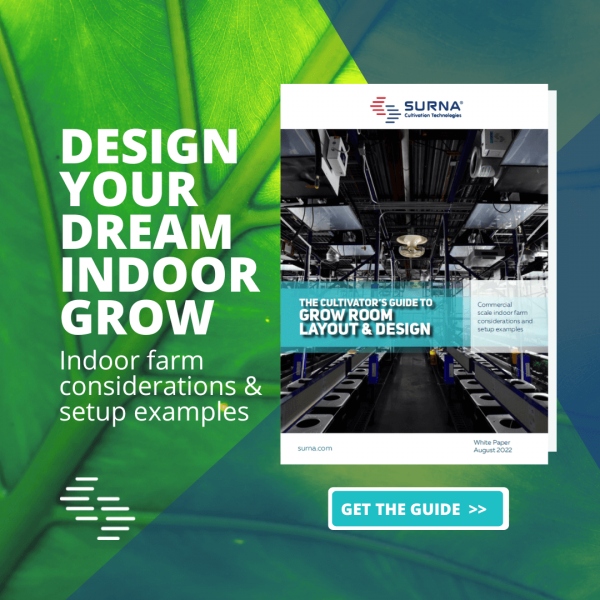Sizing for Cannabis
Sizing systems for cannabis cultivation can be very different from sizing them for other environments due to the high heat load and water content associated with a garden. Proper climate control systems for indoor gardens are often compared to those needed for data centers, but in reality, the amount of moisture in the air in a garden makes it more similar to cooling a data center that is underwater. As you can probably imagine, this distinction makes a big difference.
When selecting climate control equipment, seek the help of qualified experts. This means talking to engineers who specialize in cannabis cultivation equipment sizing. It is common for engineers without experience with controlled climate agriculture to undersize their designs. Dehumidification load alone needs to be calculated at least 5 gallons per light per day; however, it is often calculated at only 3 gallons per light per day by beginners.
Building the right sized garden
When planning a new cannabis business, it can be tempting to aim for the largest allowable square footage and plant count. However, the correct way to determine how large your operation will be is to determine the budget, determine what equipment can be bought with that money and then decide what size garden can be built within that budget.
At this point, it is important to point out that “determining what equipment can be bought” does not mean looking at the cheapest equipment and making decisions based upon that information. Instead, your business goals and monthly expenses should be considered. Energy efficient equipment is crucial to the ultimate bottom line of your business and should be considered from the start. By spending a little more money up-front to purchase good equipment, you’ll be able to save yourself time and money down the line, leading to more profits.
If you are concerned with not building a large grow to begin with, think about this: the better your start-up operation runs and the less it costs each month to keep the lights on, the more quickly you will be able to turn a profit and gain recognition for your outstanding product. Once that happens, it will be easy to find financing to expand your cultivation facility. So, start small and create the best possible grow you can with the money you have, then expand later to create the size garden you originally dreamed of.
Choosing Equipment
The Most Overlooked Aspect
One of the most overlooked pieces of equipment in a garden is the dehumidifier. Dehumidification load is higher than the cooling load in a grow room due to the amount of water present.
In fact, cooling is actually a byproduct of dehumidification, so if you have enough dehumidification, there will be enough cooling as well. An undersized dehumidifier can lead to moldy buds and other problems, so make sure to consider dehumidification when designing a grow.
The Most Undervalued Piece of Equipment
CO2 is one of the most undervalued aspects of an indoor garden. Plants need CO2 to grow and without sufficient levels, their growth will be stalled. In sealed grow rooms, it is critical to add CO2 in order to keep a constant supply in the room for plants to use. (Don’t worry, this won’t affect human occupation of the room as plants “inhale” CO2 and “exhale” oxygen, meaning there will be plenty of oxygen in a room full of plants.) CO2 supplementation is essential for boosting production and increasing plant yield.
Lighting
- Growers can choose between HID and LED lights to provide artificial lighting for plants. HIDs tend to be less expensive than LEDs, however LEDs are more energy efficient.
- Lighting spectrum should be considered as part of your garden’s “recipe,” as each color has varying effects on cannabis.
- While you can reference PPFD maps to estimate output, you should work with your lighting vendor to develop a more accurate lighting map of your grow room as a whole.
Cooling
- Buy cooling products designed for process cooling, not comfort cooling. Comfort cooling is designed to keep humans comfortable, process cooling is designed to handle and remove large amounts of heat. Using the proper type of equipment can make your facility more efficient.
- When estimating costs for HVAC equipment, keep cost per ton in mind to get the most performance out of your dollar. The relationship between your HVAC sizes and costs will change depending on a number of factors including technology, room size, and overall facility square footage.
- Choose redundancy. Cooling is a critical aspect of a functioning grow room, so it is important that cooling be available when needed. Choosing a system that allows for redundancy ensures your garden will always have cooling.
As you plan your new cultivation facility, remember these three things and you will be okay. (1) Let professionals size your equipment. (2) Build the right size garden for your budget. (3) Take care when selecting equipment and don’t overlook critical pieces.

